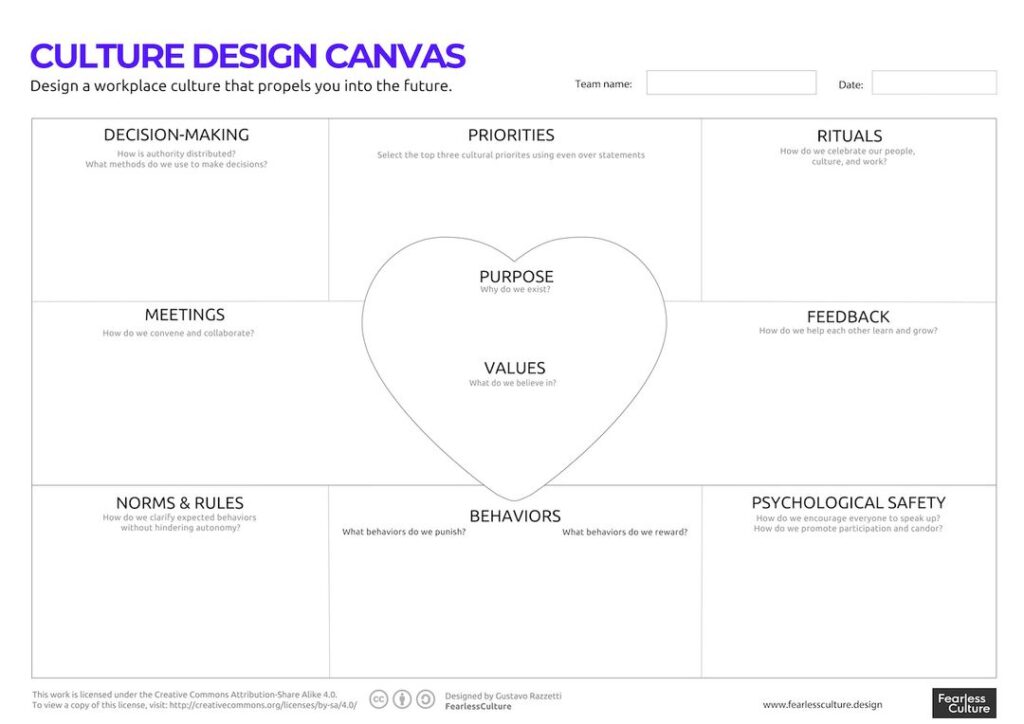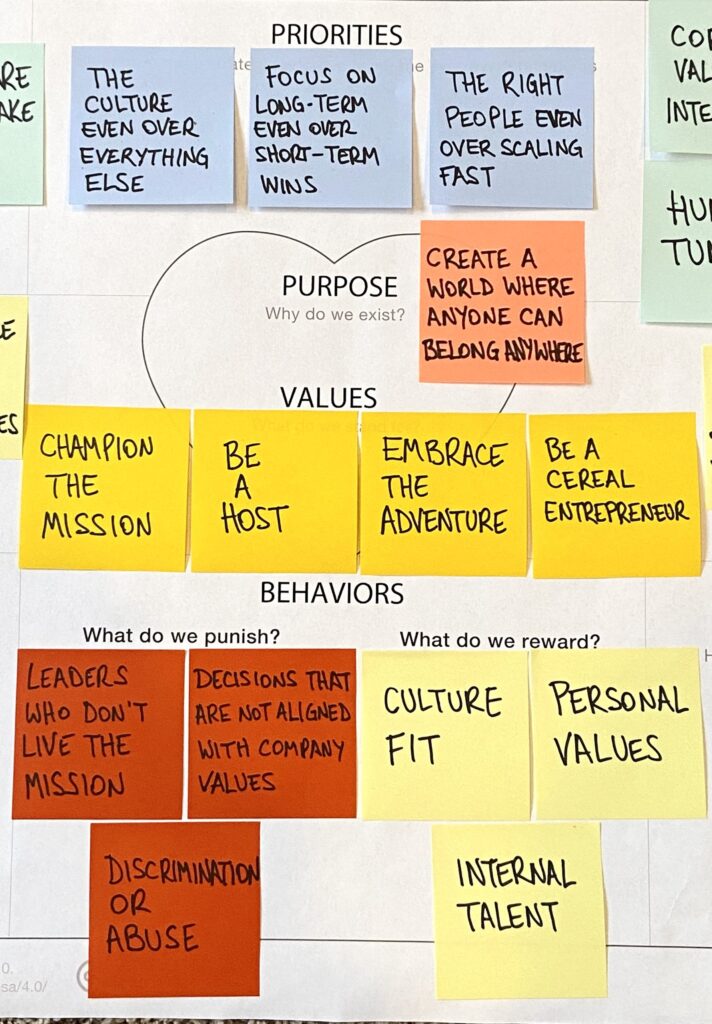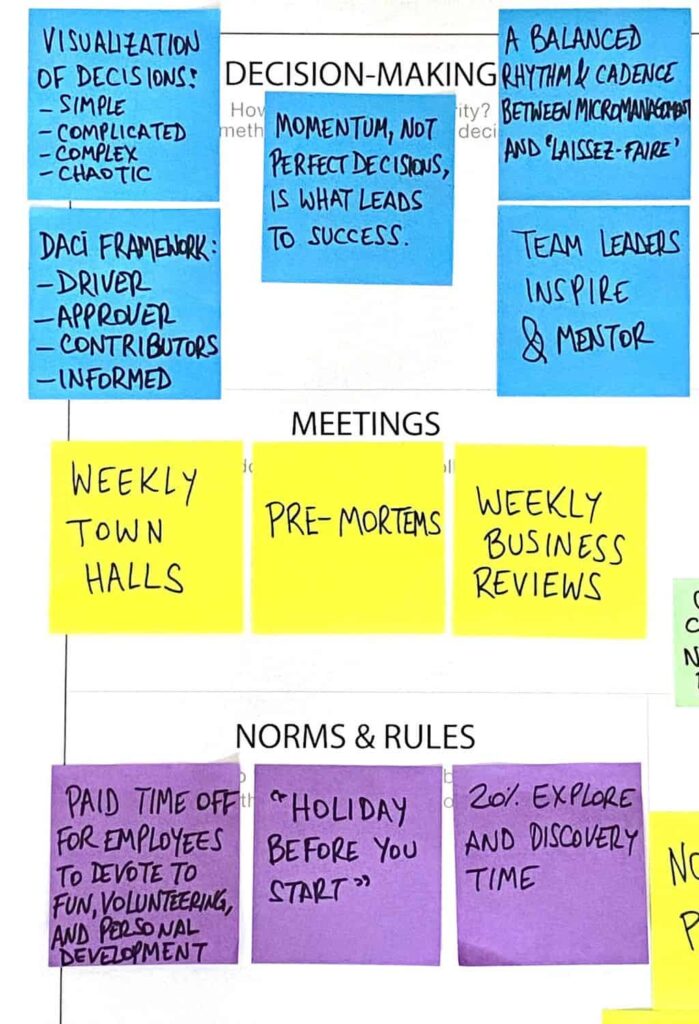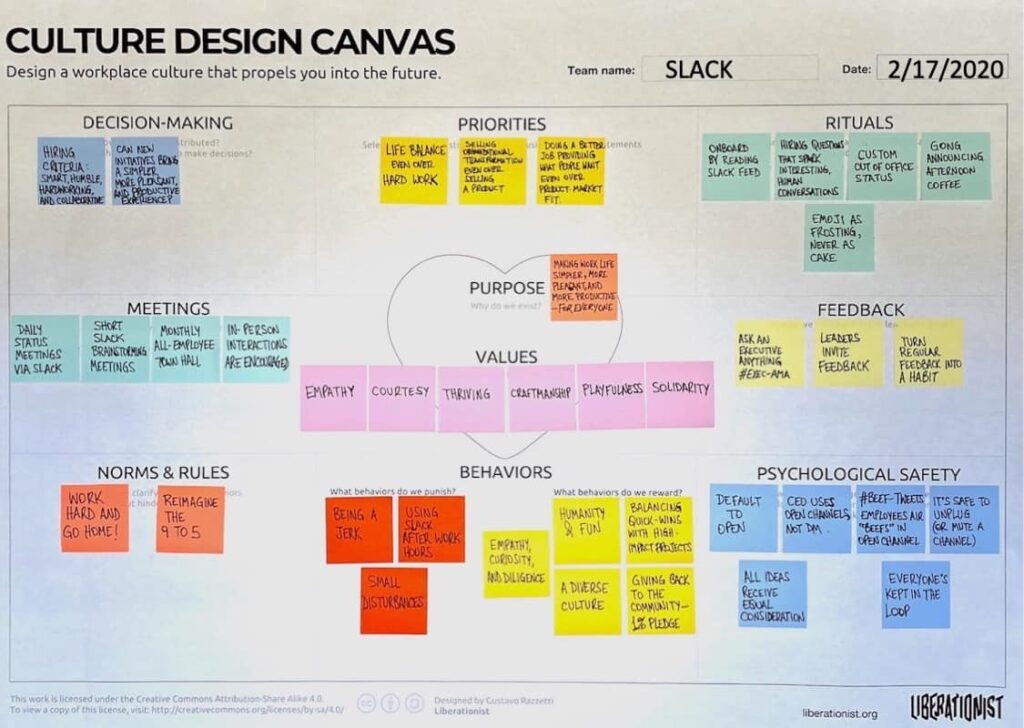
The Culture Design Canvas is more than just a tool; it’s the framework we use at Fearless Culture for helping organisations and teams build a positive workplace culture.
The Canvas is a culture blueprint to provide clarity, facilitate alignment, and uncover areas for development.
Mapping your workplace culture makes it easier for people to understand what your organisation stands for. It also helps to identify the gaps between current and desired states.
You can use it to map your own workplace culture, design a new one, or map the culture of your competitors.
Prior to the culture design session, build your dream team. Assembling the right group of people is crucial to designing workplace culture. Participants should be diverse in terms of seniority, tenure, business units represented, skills, and perspectives.
The task of designing your company culture should not be limited to the usual “culture types.” You want to explore the culture through a broader perspective; avoid the typical culture committee composed of a couple of HR folks, the CEO, and two trusted executives.
Gather all relevant information and documents: purpose, values, culture surveys, company rules and policies, etc.
Have everyone read the materials before the session.
Create a draft version of the canvas, writing big ideas on large post-its. Think of this as your first prototype. Don’t overthink it. Each participant should do this on their own before they start working together.
The Culture Design Canvas has 10 building blocks categorised in three sections:
– The Core
– The Emotional Culture
The Functional Culture
A mistake commonly made is to fill them all at once or in a random order. Follow these steps to map or design your culture successfully..

The Core is the foundation of your culture; it defines what your company stands for. The central part of the culture also focuses on the long-term vision and the impact the company wants to create in the community, employees, and marketplace.
When mapping your culture with our tool, we recommend starting with the core. The same way that, when building a house, you would start by building the foundation before erecting the walls.
Many companies already have some sort of mission, vision, or values. Some even have gone through the definition of a purpose that is less self-serving.
Start by capturing those. If you haven’t done that exercise thoroughly, this will require external facilitation or a specific session to take care of it.
The organizational purpose is the impact a company creates on people and the broader community, not just on the business or market in which it operates.
A purpose is the ‘why’ that moves employees into action. People want to be part of something bigger than themselves; the purpose is the North Star that guides our course, especially during stormy weather.
For example:
Google’s purpose is to: “Organize the world’s information and make it universally accessible and useful.”
Outdoor company Patagonia’s purpose is ”We are in business to save the planet.”
Corporate values are like a code of conduct – they are fundamental beliefs that guide your employees’ behavior. Values need to be practiced, not just spoken.
Your corporate values offer guidelines on the expected mindsets and behaviors. They guide how to achieve the company’s purpose.
Google’s values are best articulated by their famous phrase, “Don’t be evil.“
American Express’ values include customer commitment, a will to win, and personal accountability.
What are the core strategies that will guide focus and energy? Establishing clear priorities is vital to facilitating decision-making.
When everyone is aware of what matters, it’s easier to make the right choices.
Strategy is the art of sacrifice. Establish clear priorities using even-over statements.
Examples:
‘Durability even over style’ could work for a company like Ikea.
‘Wow our Customers even over sales profit’ captures Zappos’ customer-centric approach.
Choose the top three strategies and add them to the Culture Design Canvas.
Most companies have incoherent behaviours. They preach one thing and reward another.
Your culture is the behaviour you reward and punish. Values are useless if there aren’t brought to life through everyday actions.
What behaviours do we reward? What behaviours do we punish?
Spotify rewards ideas. In the music streaming company, “Ideas, not highest paid grade, win.”
On the other hand, Spotify punishes “politics” and “micromanagement.”




Watch this video to learn more about the tool , or join a Masterclass and become a certified facilitator .
The Culture Design Canvas was created by Gustavo Razzetti (Copyright © 2019- 2023 by Gustavo Razzetti and licensed under the Creative Commons Attribution 4.0 International License. You can use it for free but need to follow the following:
Attribution — You must give appropriate credit (author name: Gustavo Razzetti, link to the original canvas: https://fearlessculture.design/canvas, and provide a link to the license) and indicate if changes were made. You may do so in any reasonable manner, but not in any way that suggests the licensor endorses you or your use.
Artwork by Moira Dillon.